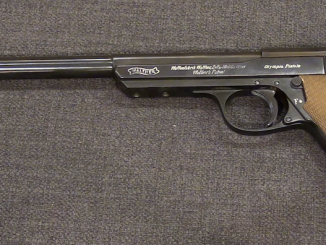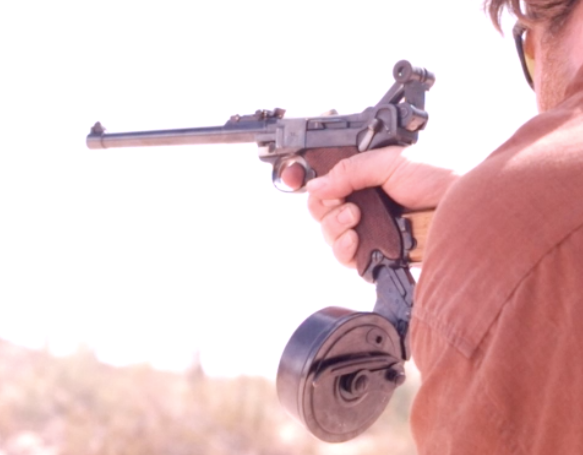This rifle is lot #1414 at Morphy’s April 2019 auction.
The Dreyse needle fire rifle was invented by Niclaus von Dreyse in 1836, adopted by Prussia in 1841, and would serve as their standard military rifle for 30 years, undergoing constant tweaking and improvements. By 1871, however, the days of the needle fire were coming to a rapid end, as it was rendered obsolete by the development and perfection of the metallic self-contained cartridge.
After the death of Nicolaus von Dreyse in 1867, his son Franz took over the company. Franz was also a talented designer, and devised a modification of the basic Dreyse system to allow for automatic cocking upon opening the bolt (as we would associate with any “normal” bolt action design today) instead of the more complex manual of arms required before. This was patented in 1874 and put into production in 1875 in an effort to keep the needle fire Dreyse relevant in a world of new bolt action rifles. The system was used for a variety of commercial sporting rifles until about 1900, but the only government purchase was a batch of guns for the Baden border guards and customs police. Those rifles have serial numbers in the 13,000 and 14,000 range, and today’s rifle is an example of one of them.




If the primer was to be struck by the needle against the ‘anvil’ of the bullet, how can it be ‘moved back?’ Did the bullet develop a peninsula backwards into the propellant, or did a primer somehow float in the powder?
Paper cartridges evolved over time. Here is “The Chap” from Bloke on the Range loading some Chassepot ammo. https://www.youtube.com/watch?v=iahThVlF7QI
The mystery being how well the primer stayed in place. Attached to the back of the cartridge, or ‘floating’ in the primer and sustained by the tightness of the packing.
“primer”
Russian Karle needle rifle: https://commons.wikimedia.org/wiki/File:RussianFirearmsXIX_125-133_Karle.jpg?uselang=ru
used cartridge with cardboard bottom holding primer, needle pierced that cardboard and hit primer. Cartridge case combusted during firing, if anything remained it was shoved by loading next cartridge, no extractor was present. It was officially adopted in 1867, but soon found plagued by faults (powder gases escaping through breech end, needle breaking, fast accumulations of unburned powder in barrel) so 215500 examples already made were sent to internal okrugs of Russian Empire, Siberia and Turkistan.
Already in 1869 Krnka rifle was adopted: http://www.imfdb.org/wiki/Krnka_M1869_Rifle which used center-fire metallic cartridge and proved much more successful.
The Dreyse bullet was held in a papier-mache’ sabot, which held the primer cup centered and solidly against the base of the bullet. The open end of the cup, shaped rather like a conventional percussion cap, was toward the needle (firing pin), its head was hard against the base of the lead bullet. In effect, this made the base of the bullet the “anvil” against which the priming compound was struck by the firing needle.
This also meant that every time the weapon was fired, the needle was exposed to the heat and erosion of the burning powder for most of its length. The needles quickly corroded and sometimes broke as a result. Prussian soldiers carried spare needles and learned to change them quickly, much as their French opposite numbers did with the rubber bolt-head gasket plug on the Chassepot.
One other peculiarity of the Dreyse ammunition is worth noting. Due to the papier-mache’ sabot, the Dreyse bullet was nearly a perfect elliptical form, except for the flattened base for the primer to be struck against. This gave it very good aerodynamics for its time, compared to most other bullets.
Also, it was a forerunner of the 20th Century Armor-Piercing Discarding Sabot anti-tank gun shot of World War Two, in that like them, its sabot came apart, in fact disintegrated, at the muzzle, allowing the bullet to continue on with the rifling-induced spin, because it was the sabot that took the rifling.
What’s more, because it was the sabot that took the rifling, no recovered Dreyse bullet ever has distinct rifling marks on it. Naturally, this could have been handy for assassins in that era, since the military Dreyse’s caliber (18mm vs the 15.4mm diameter of the bullet) meant that you could put almost any other bullet smaller than 15mm (.60 caliber) in a sabot to fit the barrel. Even one you’d previously fired from another weapon.
Needless to say, when ballistic comparison was developed in the late 1800s, this could have been an effective way to frame somebody for almost anything.
(Yes, I used to do this for a living.)
cheers
eon
[OFF-TOPIC so ignore if you wish]
Recently Textron Systems delivered NGSW-T prototype demonstrator to US Army: https://www.army-technology.com/news/textron-ngsw-t-prototype-demonstrator/
with NGSW-T standing for Next Generation Squad Weapon-Technology
Cased-telescoped weapon-ammunition combination is said to offer improved weapon accuracy and manoeuvrability and decreases system weight by up to 40% without reducing lethality. Surely author of linked article likes to use acronyms, but how do you evaluate possibility of adoption?
Mostly, the telescoped round concept (often called Plastic-Cased Telescoped Ammunition, or PCTA) makes the feeding of very high rate of fire weapons a lot easier, notably Gatling or revolver-breech types.
An early example of this was the Dardick weapon system of the early 1960s;
https://en.wikipedia.org/wiki/Dardick_tround
Which used a case profile called a “tround”, either with a bell-shaped profile as shown in the patent drawing or later a true semi-elliptical equilateral side triangle, like the rotor in a Wankel rotary engine. The latter allowed to tround to go into the chamber any way it arrived, rather than only in one angular orientation.
Dardick concentrated on small arms; his weapons were an odd cross between revolvers and box magazine fed arms. As Chinn relates (The Machine Gun, Volume 3), the military was more interested in the application of the Dardick architecture to automatic cannon, as it allowed direct feed into the side of the chamber and direct ejection out of the side after firing, minus the necessity to ram a round in from the rear and then extract it the same way. This would give a revolver-breech gun like the Aden or a Gatling-type gun like the Vulcan a higher rate of fire simply due to subtracting two mechanical movements from the feed/fire/extract cycle.
PCTA will probably be the next generation of such heavy automatic weapons. It’s worth noting that the GAU-8 cannon on the A-10 uses plastic sleeves around its metal-cased bottlenecked cartridges to facilitate feeding by its controlled belt feed system. Replacing this two-piece arrangement with a cylindrical (or tround-shaped) PCTA round could have interesting effects on such a weapon’s rounds-per-second.
The ultimate would probably be using a combustible plastic with a slightly slower burning rate than the propellant. Meaning, it would last just long enough to provide obturation (breech sealing) while the propellant burned, and then combust, adding a bit of velocity to the projectile (we’re talking milliseconds here) and leaving nothing to extract.
This might finally solve the whole “caseless ammunition” conundrum. A cased round that in essence behaves like a caseless round in the action, minus all the usual problems with caseless ammunition as seen with the Heckler and Koch G-11. Incidentally, here’s a good article on that one;
https://www.popularmechanics.com/military/weapons/a26811332/g11-rifle/
The photos and technical data show just why it was never adopted; less expense and the collapse of the Warsaw Pact than the fact that it was a mechanical nightmare and a PITA to keep running. Not to mention that the caseless propellant, less a compressed “powder” than a desensitized high explosive, didn’t react well to things like changes in temperature and/or humidity.
A CPCTA (Combustible Plastic Cased Telescoped Ammunition) type round would have most of the advantages of a true caseless round, without a lot of the drawbacks.
Especially when it rains. 😉
cheers
eon
Sorry Ian, but you made a mistake with the flag on the still photo of the video. The rifle was procured for the GRand Duchy of Baden, which had a red and gold flag. The black-white-red is the flag of the Reich. This is like showing the stars & stripes for a gun of the Arizona State Police.